|
|
|
|
|
|
|||
|
||||||||
| Social and Cultural Life of Bochnia's Jews - Past & Present |
(Written by Dr. Rachel Kollender).
The Bochnia Jewish community - past and present - is a microcosm of the Jewish cultural and social life of many other communities, thus reflecting general historical processes on one hand, and application of traditional-canonical rules on the other hand. The Jewish community of Bochnia had ups and downs during its 700 years of existence. Jews settled in Bochnia very close to the discovery of the salt mines. As a result of the connections with other Jews all over Europe, Jews started trading with their brethren, but very soon afterwards, we find documents about a condemnation, in 1445, on the background of the salt commerce. This did not prevent them from staying in Bochnia. Documents from 1530 show that they lived on the streets of Kowalska, Sczewska, Solna Gura and Trudna. As it was the habit of Jewish congregations, they had a synagogue and a cemetery, but we do not know where they were located.
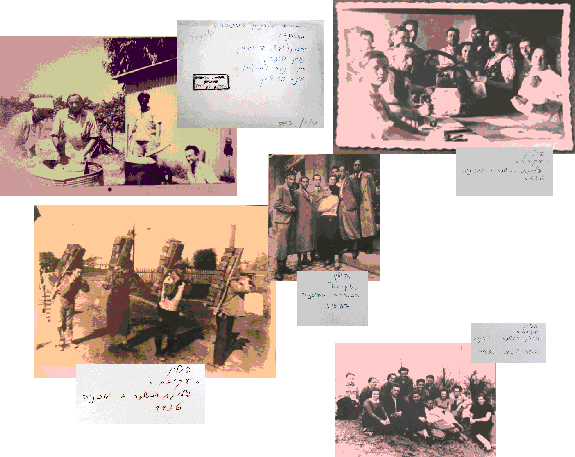
The years 1550-1750 are considered as the "golden age" of the Polish Jewry. But, for the Bochnia Jews only the first 50 years were good. In 1555, the Jews of Bochnia were granted, by king Sigmund Augustus, a general formal privilege to take part in the salt business. The most prominent personality of that period was Rabbi Chaim Bochner, a leader and author. Fifty years later, in 1605, they are expelled, again as a result of a false accusation. The Jews left Bochnia and settled in Wischniza and Krakow. They were allowed to resettle only in 1862, as a result of new privileges of the Kaiser Franz Joseph the first, king of Austria. During all these years, since 1605, around 50 Jews lived at the ends of Bochnia and had commercial relationships with the local population.
- Top Left: Laundry training in Bochnia - Aharon Friedman, Nachmna Bergerin, Ryna Nagar, Myna Fridman
- Top Right: "Akiba" Hacshara Unit, sewing class in Bochnia in 1936
- Center: "Akiba" management visiting Bochnia in 1937
- Bottom Left: "Akiba" Hacshara construction training class in Bochnia in 1937
- Bottom Right: "Akiba" Hacshara Unit in Bochnia 1937
In the period between 1860 and 1939, the number of the Jews in Bochnia increased gradually, from 200 families in 1869 to around 3,500 in 1939 - 20% of the total population of the town. One of the reason for this growth was the leadership of a very important dynasty of Rabbis since the re-establishment of the Bochnia Jewish community, until its destruction in 1943. Such spiritual and physical influence is very typical of many Jewish communities all over Europe. In Bochnia it was the Halberstam family, which overcame internal conflicts, and was very dominant in the leadership of the community.
The Jews of Bochnia were involved in both local and congregational affairs. For example, when Kaiser Franz Joseph visited Bochnia, a Jewish delegation welcomed him, thus expressing their involvement in the town's general affairs. Jews were involved also in the commercial life, mainly in the fields of food, dressing, metal and leather.
At the same time, they developed a vivid, autonomous Jewish society, of rich and poor members, with many synagogues, houses of worship and schools. Their life was leaning on charity and social aid. Financial stability was very important for them, especially after the first world war, therefore they established a private credit bank, and later a cooperative one. In addition, they had monetary funds of non-profit loans, volunteers who visited and helped the sick, supply of basic products for the poor, special free hotels for passengers, orphanages for children, a hospital, and a library. Courses in Hebrew were very popular.
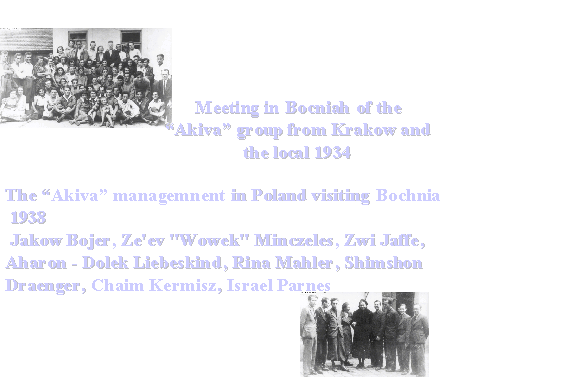
The Zionist Organization was also active in Bochnia, mainly through the youth movements. The variety of these movements, including different religious, Zionist, socialist and even radical groups, represents the large scope of ideologies that were popular not only among the youngsters, but also among the Jewish families. Each group had its own club, emblem, code and hymn, and was in touch with active members in other settlements. Some of them joined the communist organizations, had good relationships with the local movements, and in some cases the leftist workers even protected the Jewish population against the anti-Semitic waves of the 30's, in Bochnia and in the neighborhood.
The cemetery, as a peaceful, silent testimony of the history of the community, was established in 1872, at the period of the pollution that attacked the district. From documents that exist in Wiszniza we learn that Bochnia Jews were buried in the Wiscniza cemetery even after the cemetery in Bochnia had been established. Only towards the 80's of the 19th century had the cemetery in Bochnia become the common eternal rest-place for the Bochnia Jews. The last grave is from 1945. Today, the cemetery is in good condition, and is one of the best preserved cemeteries all over Poland.
Unfortunately, the cemetery is not the place of testimony of the Holocaust. Also, there is no memorial book about Bochnia, but such books of other vanished communities contain details also about the Bochnia ghetto. In addition, there are numerous sites on the world wide web, as well as historical research and testimonies about survivors and stories about those that did not survive. These are our main sources about the Bochnia Jewish community since the outbreak of the war, during the forced labor period, which the Jewish population was subjected to, then, the formation of the ghetto in 1941 and its final liquidation in September-October 1943.
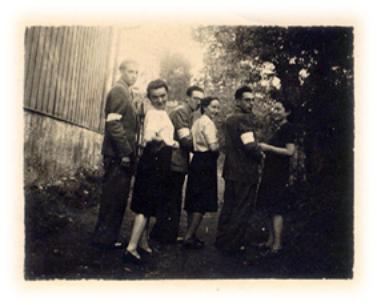
Not only Bochnia citizens were concentrated in the town. The population increased because more and more refugees came into the ghetto from all over west Galicia. Documents and lists that remained show a total of 15,000 Jews, most of them inhabitants in the local Jewish small quarter. One of the reasons for this attitude was the industry. Maybe the luckiest event in Bochnia during the war was the establishment and functioning in full engine of factories and workshops. They were founded by Sallo Greiwer, at a quite early stage of the war, and supplied goods for the Germans, with short breaks, until the entire-final liquidation, in August 1943. During some periods, this industry employed around 3,000 people, from the whole district. Even an elementary school was established for the children of the workers, which functioned until august 1942, when the ghetto was divided into A - forced labor camp and B - concentration camp.
In the middle of the winter of 1940, the rule of the white badge with the blue star of David started. Still, Jews attempted to do whatever they possibly could to maintain a normal life routine within the boundaries, while all other Jewish congregations around Bochnia had vanished. The Bochnia ghetto was the last one to survive on the earth of Poland.
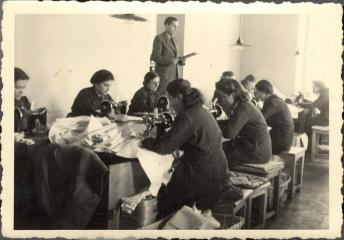
Two organizations were active in the ghetto - the Judenrat, which sometimes went way beyond the call of duty, and the Ordnungsdienst, the Jewish police, which was responsible for the order, thus fulfilling the German commands.
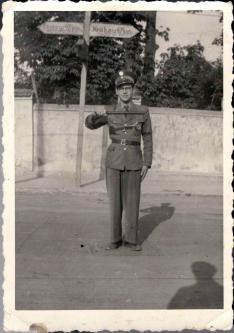
As a result of the massive liquidations of August and November 1942, the old and sick were deported to Basckow forest and killed there, the rest were sent to Belzec and murdered there.
After the final liquidation, Bochnia was cleared of Jews. Most of them were killed or deported to Szebnia, or to Plaszow, Krakow, some fled into the woods and joined the partisans, others who were discovered were shot on the spot. The remnants of the community were left to clean the ghetto, to prepare it Judenrein, for the Germans.
The significant feature of the Jewish partisan movement in Poland was that almost all Jewish partisans started their activities at a very early period - the second half of 1942, when the Polish partisan movements hardly existed. In this aspect, too, Bochnia reflects many other town. As in other Jewish communities, the youth movements were a source of manpower, and conducted cultural education, illegal publications, and preparation for armed resistance. They collaborated with other groups of the district. The leaders of the Krakow underground, for example, collaborated with the Z.O.B. organization in Bochnia, and hid, for a while, in the town. For some unknown reasons, in spite of its role, Bochnia was hardly mentioned in history books in reference to the Jewish rebellion of 1942, but it had played an important role in its creation and its demise.
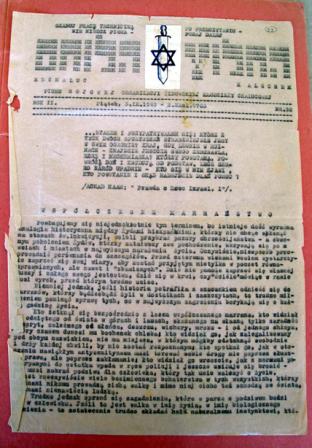
To the left (click to enlarge) is a photograph of the undrground journal, published in Krakow and Bochnia Ghetto, with the original emblem of HeChalutz HaLochem, the fighting organization of the Pioneer Jews. .
The attitude of the Poles to the Jews all over Poland was marked by both active participation in murder and rescue efforts at great risk. Those who rescued Jews in Bochnia, like Romansky, Kowalik or Fischer, were granted the title of "righteous of the nations". About 80 Jews from Bochnia survived the war. The situation in Bochnia after the war resembled that of all other Polish towns and villages. Most of the very few survivors who managed to hide in the woods near Bochnia were killed by local Poles. Also the Armia Krayowa was unfriendly to them. Those Jews who managed to reach Bochnia were not welcomed by the local population. For their own protection, the surviving Jews moved from the Bochnia region to Krakow. This act of gathering in the metropolitan was typical in other districts as well. No Jewish community was re-established in Bochnia after the war.
This site is hosted at no cost by JewishGen, Inc., the Home of Jewish Genealogy.
If you have been aided in your research by this site and wish to further our
mission of preserving our history for future generations, your
JewishGen-erosity is greatly appreciated.Jewish Gen Home Page | KehilaLinks Directory
Compiled by Eilat Gordin Levitan. Updated February 5, 2020 Copyright © 2007 Eilat Gordin Levitan (eilat.gordinlevitan@gmail.com).